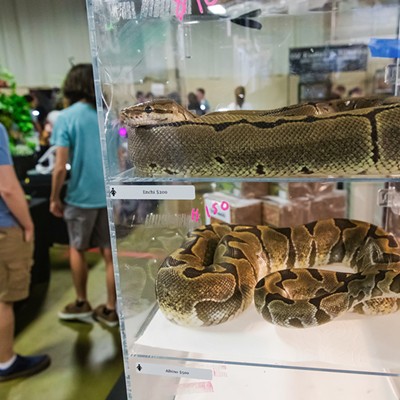Dori Villalon has fostered kittens, puppies, adult dogs, and other animals recovering from medical treatment or an injury to help get them ready for adoption while working with Santa Barbara Humane.
“For me I always went in knowing that I’d give them the temporary love and care they need in order to move on,” said Villalon, chief operating officer of the nonprofit. “I’m just helping them get to the next stage in their life; it’s not forever—‘I’m going to raise you with love and let you go with love because I know there’s somebody else who will give you a forever home.’”
Villalon’s coworkers also fostered animals—or temporarily taking animals home to get them out of the shelter for enrichment time, training assistance, healing from injury or trauma, or raising animals from babies to be ready for adoptions. Villalon adopted her own two kittens after a co-worker fostered them as babies.
“You’re so proud of them, and you see these animals progress and you know that you’ve provided them with a stable environment to grow and heal,” she said. “You’re proud of them and you’re proud of what you’ve done.”
Volunteering to foster not only helps the animal’s well-being, but it helps the shelters, specifically Santa Barbara County and other government-affiliated shelters that face overcrowding, Villalon said.
“If someone who’s doing animal care as part of their work and they are caring for a couple hundred animals a day, to take one of those animals and be personally involved in its pathway can be really satisfying,” she said. “We’re all in this business because we want these animals to succeed and make a positive impact.”
Santa Barbara County Animal Services has 639 animals in its three county shelters and partner agencies, and an additional 350 animals are in foster care as of Oct. 12, said Sarah Aguilar, director of Animal Services.
“I have an entire shelter-and-a-half worth of animals living in homes right now,” Aguilar said. “If we didn’t have those foster caretakers, we would definitely be euthanizing for space because there’s zero capacity to be sheltering an additional 350 animals currently.”
High community engagement and being in an animal-friendly community have kept Animal Services from making tough decisions around euthanasia to respond to overcrowding, but “it constantly feels like we could tip in that direction,” Aguilar said.
“On any given day we’re walking this really fine line of being full. We get anywhere from five to 20 animals every day, and anywhere from five to 20 leaving. On days where 20 come in and five leave, it’s tight,” she said. “That’s every day we’re seeing that.
“There are times when we have to house dogs in crates temporarily; there are times where we have to drop these sliding doors in our kennels and cut the amount of space dogs have in half.”
Fostering gets the animals out of high stress situations and into a home environment that they’re used to, she said.
“I don’t know that the community understands that even just a day trip or a couple hours away from the shelter has such a huge impact,” Aguilar said. “Think about if you were at work all day, 24 hours a day and something was always due, that is the sort of stress shelter pets experience.”
While humans get the weekend or an afternoon to get lunch, the pets in the shelter don’t get that break, she said. Studies have been done on shelter animals’ cortisol levels, which have indicated that when they leave a shelter their stress levels go down and when they return it’s not any higher than it was before.
“That time off gives them some relief without a worse experience upon return. For us, we think about human emotions and we feel anxiety about [what’s to come]. Animals don’t feel that,” Aguilar said. “They are more of an in-the-moment type, when they are in the shelters they are stressed, when they are out of the shelter they are not stressed.”
Through fostering, Animal Services can also learn more about an animal’s behavior that they can’t learn in a shelter environment—like if a dog knows how to use a dog door or if they get onto furniture, or if a cat is more independent or if they like to cuddle with their human, she said.
“The more we learn about a pet’s personality at home, the more we can do about matching the pet for a family,” Aguilar said.
The best way for people to start fostering is by going to an Animal Services facility and talking to an employee about their interest. The employees can then learn about the person’s lifestyle and what level of commitment they want.
“Fostering is a great option for folks who travel for work or they’re retired or only in one area for a couple of months because they can really help the shelter, help a pet out, and not have this lifetime commitment of providing care,” Aguilar said.
In the fall, Animal Services typically looks for help with puppies and large dogs, and in the spring the department needs kitten fosters, she added. Once people receive their foster animal, Animal Services provides the volunteer with the food, crates, medicine, and toys they’ll need for the time of the animal’s stay.
“One of the things we hear from folks is, ‘I couldn’t take a pet to my house, my house is too small.’ I guarantee your house is bigger than a kennel,” Aguilar said.
They will also hear from residents that it’s too hard to give up an animal after fostering, but Aguilar said understanding that there’s an end date can be very helpful for people interested in fostering.
“Going into it, you have this mindset that there’s an end and understanding the benefits of that short break from the stress of the shelter makes that experience beneficial,” she said.
After filling out some paperwork, people can get matched and leave the shelter with a pet for a few hours, a weekend, or for a few months and can continue increasing their commitment levels, she said.
“We try to make it as easy as possible; we believe people are the solution to the challenge of meeting pet needs,” Aguilar said. “We welcome anybody and everybody to be a part of the solution in the way they have the capacity.”
Reach Staff Writer Taylor O’Connor at [email protected].















